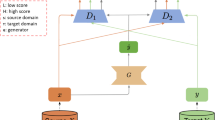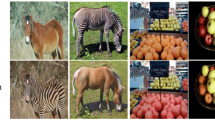Abstract
We consider image transformation problems, and the objective is to translate images from a source domain to a target one. The problem is challenging since it is difficult to preserve the key properties of the source images, and to make the details of target being as distinguishable as possible. To solve this problem, we propose an informative coupled generative adversarial networks (ICoGAN). For each domain, an adversarial generator-and-discriminator network is constructed. Basically, we make an approximately-shared latent space assumption by a mutual information mechanism, which enables the algorithm to learn representations of both domains in unsupervised setting, and to transform the key properties of images from source to target. Moreover, to further enhance the performance, a weight-sharing constraint between two subnetworks, and different level perceptual losses extracted from the intermediate layers of the networks are combined. With quantitative and visual results presented on the tasks of edge to photo transformation, face attribute transfer, and image inpainting, we demonstrate the ICo-GAN’s effectiveness, as compared with other state-of-the-art algorithms.
Similar content being viewed by others
References
Buades A, Coll B, Morel J M. A non-local algorithm for image denoising. In: Proceedings of the IEEE Conference on Computer Vision and Pattern Recognition. 2005, 60–65
Elad M, Aharon M. Image denoising via sparse and redundant representations over learned dictionaries. IEEE Transactions on Image Processing, 2006, 15(12): 3736–3745
Pan J, Ren W, Hu Z, Yang M H. Learning to deblur images with exemplars. IEEE Transactions on Pattern Analysis and Machine Intelligence, 2019, 41(6): 1412–1425
Cruz C, Mehta R, Katkovnik V, Egiazarian K O. Single image super-resolution based on wiener filter in similarity domain. IEEE Transactions on Image Processing, 2018, 27(3): 1376–1389
Huang Y, Li J, Gao X, He L, Lu W. Single image superresolution via multiple mixture prior models. IEEE Transactions on Image Processing, 2018, 27(12): 5904–5917
Pathak D, Krahenbuhl P, Donahue J, Darrell T, Efros A A. Context encoders: feature learning by inpainting. In: Proceedings of the IEEE Conference on Computer Vision and Pattern Recognition. 2016, 2536–2544
Ding D, Ram S, Rodriguez J. Perceptually aware image inpainting. Pattern Recognition, 2018, 1: 174–184
Zhang R, Isola P, Efros A A. Colorful image colorization. In: Proceedings of the European Conference on Computer Vision. 2016, 649–666
Wang C, Xu C, Wang C, Tao D. Perceptual adversarial networks for image-to-image transformation. IEEE Transactions on Image Processing, 2018, 27(8): 4066–4079
Isola P, Zhu J Y, Zhou T, Efros A A. Image-to-image translation with conditional adversarial networks. In: Proceedings of the IEEE Conference on Computer Vision and Pattern Recognition. 2017, 1125–1134
Sangkloy P, Lu J, Fang C, Yu F, Hays J. Scribbler: controlling deep image synthesis with sketch and color. In: Proceedings of the IEEE Conference on Computer Vision and Pattern Recognition. 2017, 5400–5409
Zhu, J Y, Park T, Isola P, Efros A A. Unpaired image-to-image translation using cycle-consistent adversarial networks. In: Proceedings of the IEEE International Conference on Computer Vision. 2017, 2223–2232
Liu M Y, Breuel T, Kautz J. Unsupervised image-to-image translation networks. In: Proceedings of the 31st International Conference on Neural Information Processing Systems. 2017, 700–708
Kim T, Cha M, Kim H, Lee J K, Kim J. Learning to discover cross-domain relations with generative adversarial networks. In: Proceedings of the 34th International Conference on Machine Learning. 2017, 1857–1865
Huang X, Liu M Y, Belongie S, Kautz J. Multimodal unsupervised image-to-image translation. In: Proceedings of the European Conference on Computer Vision. 2018, 172–189
Dong C, Loy C C, He K, Tang X. Image super-resolution using deep convolutional networks. IEEE Transactions on Pattern Analysis and Machine Intelligence, 2015, 38(2): 295–307
Shelhamer E, Long J, Darrell T. Fully convolutional networks for semantic segmentation. IEEE Transactions on Pattern Analysis and Machine Intelligence. 2017, 39(4): 640–651
Radford A, Metz L, Chintala S. Unsupervised representation learning with deep convolutional generative adversarial networks. 2015, arXiv preprint arXiv: 1511.06434
Goodfellow I, Pouget-Abadie J, Mirza M, Xu B, Warde-Farley D, Ozair S, Bengio Y. Generative adversarial nets. In: Proceedings of the 27th International Conference on Neural Information Processing Systems. 2014, 2672–2680
Liu M Y, Tuzel O. Coupled generative adversarial networks. In: Proceedings of the 30th International Conference on Neural Information Processing Systems. 2016, 469–477
Lai W S, Huang J B, Ahuja N, Yang M H. Fast and accurate image superresolution with deep laplacian pyramid networks. IEEE Transactions on Pattern Analysis and Machine Intelligence, 2018, 41(11): 2599–2613
Dong W, Wang P, Yin W, Shi G. Denoising prior driven deep neural network for image restoration. IEEE Transactions on Pattern Analysis and Machine Intelligence, 2019, 41(10): 2305–2318
Ma L, Sun Q, Georgoulis S, Gool L V, Schiele B, Fritz M. Disentangled person image generation. In: Proceedings of the IEEE Conference on Computer Vision and Pattern Recognition. 2018, 99–108
Murez Z, Kolouri S, Kriegman D, Ramamoorthi R, Kim K. Image to image translation for domain adaptation. In: Proceedings of the IEEE Conference on Computer Vision and Pattern Recognition. 2018, 4500–4509
Tran L, Yin X, Liu X. Representation learning by rotating your faces. IEEE Transactions on Pattern Analysis and Machine Intelligence, 2019, 41(12): 3007–3021
Lin J, Xia Y, Qin T, Chen Z, Liu T Y. Conditional image-to-image translation. In: Proceedings of the IEEE Conference on Computer Vision and Pattern Recognition. 2018, 5524–5532
Li R, Pan J, Li Z, Tang J. Single image dehazing via conditional generative adversarial network. In: Proceedings of the IEEE Conference on Computer Vision and Pattern Recognition. 2018, 8202–8211
Wang T C, Liu M Y, Zhu J Y, Tao A, Kautz J, Catanzaro B. High-resolution image synthesis and semantic manipulation with conditional gans. In: Proceedings of the IEEE Conference on Computer Vision and Pattern Recognition. 2018, 8798–8807
Regmi K, Borji A. Cross-view image synthesis using conditional gans. In: Proceedings of the IEEE Conference on Computer Vision and Pattern Recognition. 2018, 3501–3510
Dolhansky B, Ferrer C C. Eye in-painting with exemplar generative adversarial networks. In: Proceedings of the IEEE Conference on Computer Vision and Pattern Recognition. 2018, 7902–7911
Huang X, Liu M Y, Belongie S, Kautz J. Multimodal unsupervised image-to-image translation. In: Proceedings of the European Conference on Computer Vision. 2018, 172–189
Lee H Y, Tseng H Y, Huang J B, Singh M, Yang M H. Diverse image-to-image translation via disentangled representations. In: Proceedings of the European Conference on Computer Vision. 2018, 35–51
Ma L, Jia X, Georgoulis S, Tuytelaars T, Van Gool L. Exemplar guided unsupervised image-to-image translation. 2018, arXiv preprint arXiv:1805.11145
Chen X, Duan Y, Houthooft R, Schulman J, Sutskever I, Abbeel P. Infogan: interpretable representation learning by information maximizing generative adversarial nets. In: Proceedings of the 30th International Conference on Neural Information Processing Systems. 2016, 2172–2180
Bruna J, Sprechmann P, LeCun Y. Super-resolution with deep convolutional sufficient statistics. 2015, arXiv preprint arXiv:1511.05666
Johnson J, Alahi A, Li F F. Perceptual losses for real-time style transfer and super-resolution. In: Proceedings of the European Conference on ComputerVision. 2016, 694–711
Gatys L, Ecker A S, Bethge M. Texture synthesis using convolutional neural networks. In: Proceedings of the 28th International Conference on Neural Information Processing Systems. 2015, 262–270
Donahue J, Krähenbühl P, Darrell T. Adversarial feature learning. 2016, arXiv preprint arXiv:1605.09782
Wang Z, Bovik A C, Sheikh H R, Simoncelli E P. Image quality assessment: from error visibility to structural similarity. IEEE Transactions on Image Processing, 2004, 13(4): 600–612
Yu A, Grauman K. Fine-grained visual comparisons with local learning. In: Proceedings of the IEEE Conference on Computer Vision and Pattern Recognition. 2014, 192–199
Zhu J Y, Krähenbühl P, Shechtman E, Efros A A. Generative visual manipulation on the natural image manifold. In: Proceedings of the European Conference on Computer Vision. 2016, 597–613
Xie S, Tu Z. Holistically-nested edge detection. In: Proceedings of the IEEE Conference on Computer Vision. 2015, 1395–1403
Zhang R, Isola P, Efros A A, Shechtman E, Wang O. The unreasonable effectiveness of deep features as a perceptual metric. In: Proceedings of the IEEE Conference on Computer Vision and Pattern Recognition. 2018, 586–595
Liu Z, Luo P, Wang X, Tang X. Deep learning face attributes in the wild. In: Proceedings of the IEEE International Conference on Computer Vision. 2015, 3730–3738
Acknowledgements
The authors are grateful to the support of National Key R&D Program of China (2018YFB1600600), the Natural Science Foundation of Liaoning Province (2019MS045), the Open Fund of Key Laboratory of Electronic Equipment Structure Design (Ministry of Education) in Xidian University (EESD1901), the Fundamental Research Funds for the Central Universities (DUT19JC44), and the Project of the Key Laboratory of Symbolic Computation and Knowledge Engineering of Ministry of Education in Jilin University (93K172019K10).
Author information
Authors and Affiliations
Corresponding author
Additional information
Hongwei Ge received BS and MS degrees in mathematics from Jilin University, China, and the PhD degree in computer application technology from Jilin University, China in 2006. He is currently a professor and a vice dean in the College of Computer Science and Technology, Dalian University of Technology, China. His research interests are machine learning, computational intelligence, optimization and modeling, computer vision, deep learning. He has published more than 80 papers in these areas. His research was featured in the IEEE Transactions on Cybernetics, IEEE Transactions on Evolutionary Computation, IEEE Transactions on Systems, Man, and Cybernetics Part A: Systems and Humans, Pattern Recognition, Information Science, etc.
Yuxuan Han received the BS degree from Zhengzhou University, China in 2016, and the MS degree in College of Computer Science and Technology, Dalian University of Technology, China. Her main research interests lie in computational intelligence and machine learning methods.
Wenjing Kang received the BS degree from Northeast University, China in 2016, and the MS degree in College of Computer Science and Technology, Dalian University of Technology, China. Her main research interests are deep learning, machine learning applications such as computer vision and large scale optimization.
Liang Sun received the BE degree in computer science and technology from Xidian University, China, and the MS degree in computer application technology from Jilin University, China in 2003 and 2006, respectively. During 2006–2009, as a DE candidate, he was at College of Computer Science and Technology, Jilin University, China. During 2009–2012, as a DE candidate, he was at Kochi University of Technology (KUT), Japan, as an international student of cooperation between KUT and Jilin University. He received double PhD degree from Kochi University and Jilin University in March, 2012 and June 2012, respectively. He is currently with the College of Computer Science and Technology, Dalian university of technology, Dalian, China. His main research interests lie in machine learning and deep learning.
Supporting Information
Rights and permissions
About this article
Cite this article
Ge, H., Han, Y., Kang, W. et al. Unpaired image to image transformation via informative coupled generative adversarial networks. Front. Comput. Sci. 15, 154326 (2021). https://doi.org/10.1007/s11704-020-9002-7
Received:
Accepted:
Published:
DOI: https://doi.org/10.1007/s11704-020-9002-7




